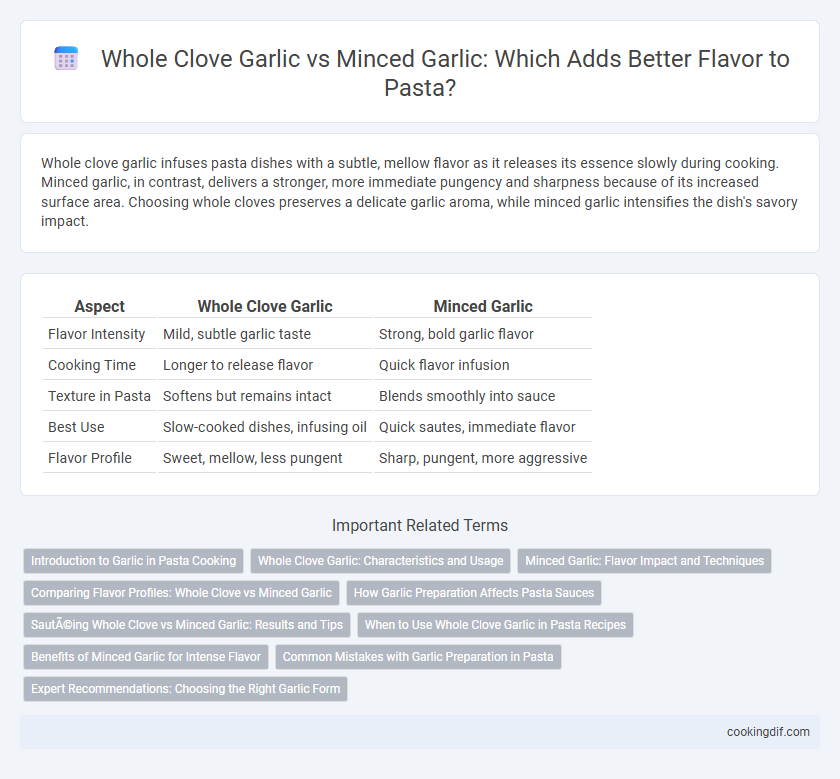Whole clove garlic infuses pasta dishes with a subtle, mellow flavor as it releases its essence slowly during cooking. Minced garlic, in contrast, delivers a stronger, more immediate pungency and sharpness because of its increased surface area. Choosing whole cloves preserves a delicate garlic aroma, while minced garlic intensifies the dish's savory impact.
Table of Comparison
| Aspect | Whole Clove Garlic | Minced Garlic |
|---|---|---|
| Flavor Intensity | Mild, subtle garlic taste | Strong, bold garlic flavor |
| Cooking Time | Longer to release flavor | Quick flavor infusion |
| Texture in Pasta | Softens but remains intact | Blends smoothly into sauce |
| Best Use | Slow-cooked dishes, infusing oil | Quick sautes, immediate flavor |
| Flavor Profile | Sweet, mellow, less pungent | Sharp, pungent, more aggressive |
Introduction to Garlic in Pasta Cooking
Whole clove garlic imparts a milder, more subtle aroma to pasta dishes as it releases flavor slowly during cooking, preserving a slight sweetness and reducing bitterness. Minced garlic, by contrast, delivers a stronger, more pungent flavor rapidly, making it ideal for recipes that require a quick, intense garlic punch. Both forms enhance pasta sauces differently, with whole cloves offering depth and minced garlic providing sharpness and immediacy.
Whole Clove Garlic: Characteristics and Usage
Whole clove garlic offers a milder, subtler flavor compared to minced garlic, releasing a gentle aroma when cooked slowly in pasta sauces. Its intact structure allows gradual infusion, preventing overpowering pungency and adding depth to dishes like aglio e olio or tomato-based sauces. Using whole cloves enables easier removal, maintaining a smooth texture while enhancing the pasta's overall flavor profile.
Minced Garlic: Flavor Impact and Techniques
Minced garlic releases a more intense and immediate flavor in pasta dishes compared to whole clove garlic, as its smaller pieces expose a greater surface area for heat to activate essential oils. To maximize flavor impact, saute minced garlic briefly over medium heat until fragrant and golden, careful to avoid burning which causes bitterness. Incorporating minced garlic early in the cooking process allows it to infuse evenly, enhancing the savory depth of sauces and dressings commonly used in Italian cuisine.
Comparing Flavor Profiles: Whole Clove vs Minced Garlic
Whole clove garlic imparts a subtle, mellow flavor that gradually intensifies during cooking, enhancing pasta dishes with a smooth, aromatic essence. Minced garlic releases a stronger, more pungent and immediate flavor due to its increased surface area, creating a robust and sharp garlic taste. Choosing whole clove over minced garlic influences the depth and intensity of garlic flavor in pasta, allowing for either gentle infusion or pronounced garlic presence.
How Garlic Preparation Affects Pasta Sauces
Whole clove garlic imparts a milder, more subtle flavor to pasta sauces as it slowly infuses during cooking without overpowering other ingredients, making it ideal for delicate tomato or cream-based sauces. Minced garlic releases stronger, more intense flavors quickly, providing a robust and aromatic punch that enhances the sauce's overall complexity. The choice between whole clove and minced garlic directly impacts the sauce's flavor profile, texture, and aroma, tailoring the pasta dish to either gentle or bold taste preferences.
Sautéing Whole Clove vs Minced Garlic: Results and Tips
Sauteing whole cloves of garlic releases a mild, sweet flavor that infuses pasta dishes without overpowering other ingredients. Minced garlic, in contrast, delivers a more intense and immediate aroma, often producing a sharper taste that can quickly become bitter if overcooked. For best results, saute whole cloves gently in oil, removing them before adding pasta, or add minced garlic towards the end of cooking to preserve its bright flavor.
When to Use Whole Clove Garlic in Pasta Recipes
Whole clove garlic infuses pasta dishes with a subtle and mellow flavor when simmered in sauces or broths, allowing a slow release of aromatic oils without overpowering other ingredients. It is ideal for recipes such as aglio e olio or slow-cooked ragu, where garlic is meant to enhance depth over time without sharp pungency. Using whole cloves also makes it easy to remove the garlic before serving, preventing bitter bites and maintaining a balanced taste profile.
Benefits of Minced Garlic for Intense Flavor
Minced garlic releases more allicin, the compound responsible for its potent aroma and flavor, resulting in a stronger, more intense garlic taste in pasta dishes. Its small pieces distribute evenly throughout the sauce, ensuring every bite is infused with robust flavor. Using minced garlic also speeds up the cooking process, allowing the flavor to blend quickly without the risk of large garlic pieces overpowering the dish.
Common Mistakes with Garlic Preparation in Pasta
Whole clove garlic in pasta sauce infuses a mild, subtle flavor but often leads to uneven seasoning as it may not fully cook or release its oils, resulting in bland spots. Minced garlic offers a stronger, evenly distributed taste, but overcooking it causes bitterness and overpowering pungency that can ruin the balance of the dish. Common mistakes include burning minced garlic by cooking it on too high heat or adding whole cloves too late, preventing proper flavor extraction.
Expert Recommendations: Choosing the Right Garlic Form
Experts recommend using whole clove garlic to infuse a subtle, mellow flavor in pasta sauces, as it releases its oils slowly during cooking. Minced garlic delivers a more intense, pungent taste, making it ideal for quick sautes or when a bold garlic presence is desired. Chefs often suggest adjusting the garlic form based on cooking time and desired flavor intensity to achieve optimal results.
Whole clove garlic vs minced for flavoring Infographic

 cookingdif.com
cookingdif.com